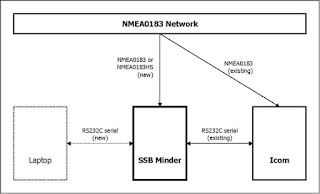Hi everyone,
HF DSC (Digital Selective Calling) is a technical topic I've posted about previously
here. We've been using routine DSC calling on Zen Again for some years now. We use it to contact individual yachts, to exchange positions with individual yachts and to contact groups of yachts. Most recently we used routine DSC calling while HF net controller during our Indian Ocean and South Atlantic Ocean crossings.
 |
| Icom HF Radio in DSC Watch |
Recently a new DSC initiative has been announced. The
NavArea Group Calling Network ("Network" below) officially establishes a set of Group IDs. Each Group ID is intended for use in one of the global NavAreas. The NavAreas are illustrated below...
 |
| NavArea Map |
The Network builds on previous work which agreed routine DSC frequencies for use by yachts. See my previous post (
here again) for the details on this. The agreement on frequencies allowed yachts to reconfigure their HF/SSB radios to scan those routine frequencies in DSC Watch and so receive routine (vice distress, urgency and safety) calls from other vessels. Distress, urgency and safety calls are still received, either by scanning a mix of distress/routine frequencies in DSC Watch or by having an antenna connected to the second antenna input on the radio. Note that distress, urgency and safety broadcasts should still be transmitted on the distress DSC frequencies!!!
Routine group calling was possible, but only if preplanned prior to a passage since a known Group ID is needed to make a Group call. In most countries the unique Group ID of a yacht is its individual MMSI shifted right by one character. So Zen Again's 503433900 becomes 050343390. So it's actually very easy to arrange a Group ID for use amongst friends. This use of DSC groups involves "closed groups" in that their ID is
not publicly known - an important point.
For our recent ocean crossings we gave our Group ID to other yachts with DSC HF/SSB radios. They added our Group ID to their radio's address list. We could then make a routine call to this Group ID and all the radios (in range) with that Group ID programmed would receive the call. If accepted their radios would change to the traffic (DSC-speak for voice) frequency and our net could start. Needless to say their radios needed to be turned on and in DSC Watch mode! This worked well.
However, what if you're at sea and want to contact
any other yacht(s) in range? This is a key advantage of the Network. By programming your radio with the Network's Group ID for your current NavArea you can make a routine call to the relevant Group ID. All vessels with this Group ID programmed and their radios in DSC Watch will receive the call. So this is a great way to make contact with other yachts in your region. It could be used to seek assistance in situations short of Urgency (DSC-speak for "PanPan"). This use of DSC groups involves "open groups" in that their ID is publicly known - an important point.
So here are the Network's Group IDs...
 |
| NavArea Group IDs |
Note that the Group ID is constructed from: "0" denoting group; three digits being the country code of the country coordinating the NavArea; two digits being the NavArea number; and "000" at the end. So they are potentially easy to construct from onboard resources in extremis! ;)
The table above is copied from Brunei Bay Radio's web page (
here) describing the Network. Allan at BBR is one of the instigators of the Network. The instigators were:
It is likely that various coast stations will start to program their radios with the Group ID for their NavArea. For example local volunteer organisations may use Network Group IDs to announce position reporting skeds. Northland Radio in New Zealand (http://www.northlandradio.nz) is already doing so. It seems likely that offshore races and rallies will start to use routine DSC calling to initiate their skeds/nets in future, and may require the Network Group IDs to be configured.
SAR organisations do
NOT monitor these Group IDs, regardless of what frequency they are used on. They listen on the distress DSC frequencies only, and for broadcasts or their individual RCC MMSIs only. Additionally it is important to understand: the distinction between distress and routine DSC frequencies; whether your HF/SSB radio has a separate DSC antenna connected; and which DSC frequencies (distress/routine and frequency bands) your radio is scanning while in DSC Watch.
The Network is a great initiative. However it suffers from the same issue which afflicts all HF/SSB radios. That is
power consumption. HF/SSB radios use a lot of power, and most yachts don't have power to spare. This initiative currently appears to presuppose yachts keep their radios on 24/7. Sadly this is not practical and most cruisers simply will not do it. A solution would be to define a watch schedule. This would fix the power issue but would we all remember?
I am developing an easily installed "black box" (working name SSB Minder) which sits alongside an Icom M802 or M801E radio, controlling it via a user-defined schedule. The SSB Minder consumes minimal power. It uses the Icom's Remote port to turn the Icom on and off per the schedule. This saves a lot of power and helps avoid missed DSC Watch periods, skeds, nets and your favourite shortwave radio program since
your radio wakes YOU up on time!!!
I will soon be seeking volunteers to trial SSB Minder prototypes
I will be posting a full description of SSB Minder in the next few days.
Congrats to Terry, Bob and Allan for initiating the Network.




















































